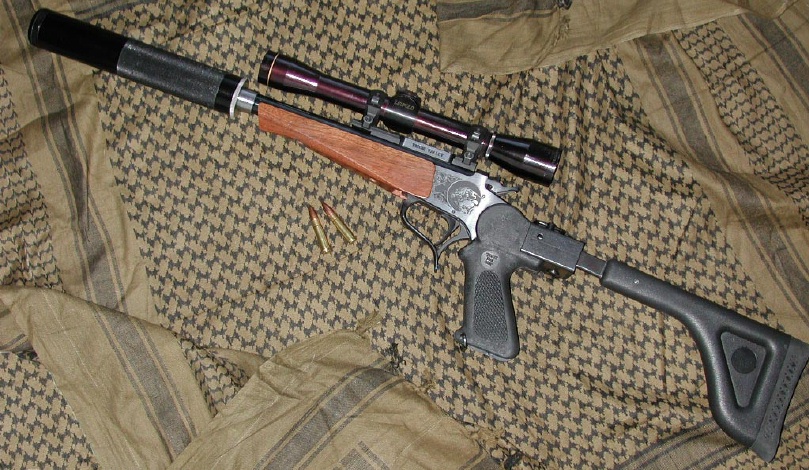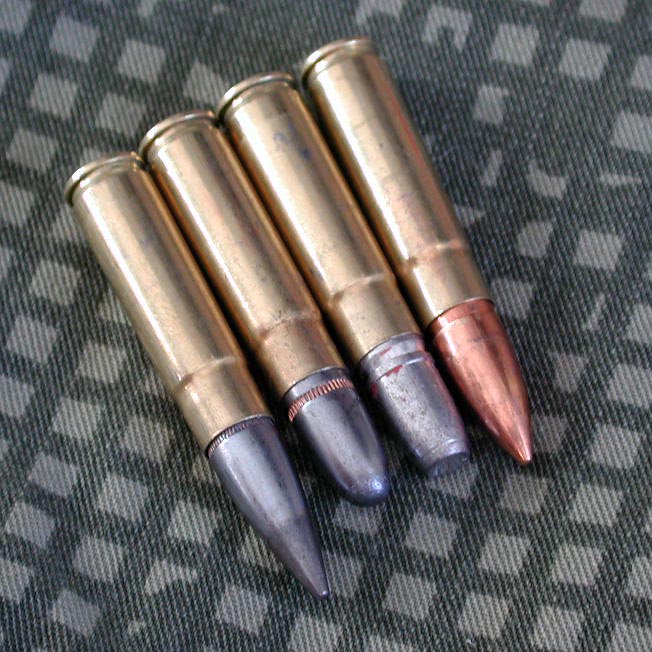Covert Whisper
by Bill Holland
The insurrection style conflict being waged in Iraq has brought forth the need for hidden or covert weapon systems that do not give away the operator or his purpose. Insurgents operate hidden within a population meaning those who hunt them must use these same tactics as much as possible. They often target snipers and other special operators. In order to remain effective in the operational area operators need weapons that are either hidden or look the same as regular soldiers.
We recently came across a neat little suppressed weapon built to look as innocuous as possible. Compact enough to fit into a briefcase or computer case but able to pack a discrete wallop when required.
It is a Thompson Centre Contender rifle with a side folding stock and 10 inch barrel chambered in 300 Whisper. The silencer is disguised as an ordinary flashlight when not on the weapon.
The Contender single-shot has been around for about 25 years and has developed a devout following due to its ability to quickly change calibers and configurations. This handy weapon offers an excellent platform for a compact, covert suppressed weapon. The single shot action reduces action noise to almost zero and ensures no tell-tale brass can be left behind.
The short barrelled rifle, with its sturdy side-folding stock can be carried either in a case or slung under a long jacket from where it can be brought into action rapidly when needed.
The 300 Whisper cartridge was designed in the early 1990ís by JD Jones of SSK Industries as a dual purpose cartridge that will operate in the M16 family of weapons. The case is currently classed as a wildcat but is offered in factory loadings by Corbon. Brass is made by necking up .221 Fireball cases to accept .308 calibre bullets. Brass can also be made by cutting down .233 Remington cases and reforming the neck. Also known as the .221-300 this case has proven to be so popular that Hornady is even including an expanding/forming die with their loading die sets.
The 300 Whisper case can operate with both conventional supersonic or subsonic loads. Supersonic loads built with a 125 grain bullet are ballistically similar to the 7.62x39 cartridge used in the AK47 and SKS rifles.
Subsonic loads can use bullets weighing from 150 grains all the way up to 240 grains. Heavier bullets donít necessarily improve the wounding potential of subsonics but they do offer more striking energy for longer range or hardened targets. Experimentation has shown that lighter bullets fly flatter and in the right configuration can offer good terminal performance (as good as can be expected from subsonics anyway).
Heavy subsonics tend to over penetrate wildly and waste their extra energy in soft targets. Subsonic projectiles are heavily dependant on calibre and shape to create a wound channel. Medium weight subsonics penetrate very deeply in soft tissue. Much of the time extra weight is just unnecessary overkill.
The only factor than can improve subsonic terminal performance is a bulletís ability to cut and crush tissue as it transits. This can be accomplished via two methods: A flat nosed bullet with sharp edges will cut tissue instead of pushing it aside as a pointed bullet will do. Otherwise, a subsonic projectile has to be able to turn sideways to present a larger surface area. Bullets with the bulk of their weight in the tail (boat-tail) or a spoon nose are the most effective at this.
The common spitzer boat-tail bullet (like a .30 calibre military bullet) is actually a very effective shape for subsonic flight. In forward flight, the pointed nose gives a better ballistic co-efficient and thus a flatter trajectory. After impact, the bullet becomes unstable and yaws 180 degrees. From then on it travels backwards presenting a sharp cutting edge (edge of the boat-tail) to disrupt tissue.
One interesting fact learned during testing is that a heavy, pointed rifle caliber subsonic bullet can penetrate Kevlar body armor. Subsonic pistol bullets cannot match this performance level due to their large cross sectional area and generally blunt nose..
In any subsonic, bullet flight stability must be balanced with terminal stability to create an accurate projectile capable of decent terminal performance. Flight instability with subsonics is a major issue because they donít follow the same general rules as their supersonic brethren. However subsonic bullets that are too stable will not exhibit instability on impact, thus limiting their terminal performance potential.
To date no subsonic bullet of conventional design are able to expand reliably in soft tissue. There are some promising frangible designs being worked on but consistent expansion at an impact velocity below the speed of sound is a non-trivial problem.
The suppressor on the Covert Whisper is a unique design built into a real Maglite flashlight. A close examination is required to reveal that the light is not functional. With the factory anodized finish retained for an unaltered look, the tube was cut off just behind the working parts of the original flashlight. The original endcap is also retained but with the addition of a .30 calibre exit hole. The flashlight head is complete but with the internal reflector trimmed slightly for clearance with the suppressor mount hidden underneath.
The suppressor mount has been threaded externally to mount the flashlight head so it canít easily fall off. This allows the flashlight/suppressor to be carried in a belt loop as a real light would be.
While this covert suppressor does not include a working light, the drawings for a more advanced design incorporating a functional flashlight do exist. This is getting into the stuff of spies and black operations where equipment must survive a more detailed examination by the bad guys.
The baffle stack is composed of machined baffles which are highly efficient at pulling gas away from the central bore to maximize gas flow disruption. The result is a highly effective silencer that produces excellent sound reduction, a pleasing signature and minimal first round pop with both subsonic and supersonic ammunition.
Supersonic ammunition produced a muzzle signature of 134 dB (30.1 dB net reduction), which is similar several decibels quieter than a Sten MK2S or an unsuppressed .22 rimfire rifle firing subsonic ammunition. This is also the sound level where suppressed subsonic .308 caliber rifles operate. Meaning the Covert Whisper is very stealthy with supersonic ammunition.
Switching to subsonic ammunition, the compact Whisper really shines. Sound signatures drop to 126 dB (27.5 dB net) which is almost as quiet as a suppressed .22 rimfire pistol. The difference being a .22 rimfire typically fires a 38-40 grain bullet where the Covert Whisper is launching 150 Ė 240 grain bullets capable of penetrating body armor at ranges beyond 100 yards. That is some serious capability for something so stealthy.
The suppressorís aluminium tube and front cap are not designed to soak up large amounts of rapid fire. This is a covert, concealable weapon for the discrete engagement and removal of point targets at ranges inside 200 yards. It is simply not meant for high intensity or open combat, however this suppressor was tested on a different rifle using a full power cartridge without blowing the endcap off or damaging the flashlight tube. Thus there is a significant safety factor when using the diminutive 300 Whisper cartridge.
Considering the effort currently being put into uprating the terminal performance of the 5.56mm cartridge, the 300 Whisper, in supersonic mode, is already there with its .30 caliber bullet. The Whisper picks up where the smaller calibers end. Supersonic Whisper loads can be built with bullets ranging from 110 grains and up.
The subsonic 300 Whisper can place an impressive amount of energy and penetration onto a target with very little sound. This makes it ideal for removing sentries, both four legged and two, as well as the selective destruction of high value equipment like radar arrays, aircraft and high ranking officers in a more discrete manner.
The small size and portability of a weapon like the Covert Whisper makes it is easy to carry into combat without interfering with other equipment or weapons.
In an insurgency type campaign such a weapon would be most useful for special-forces, non-overt government agents or other less conspicuous troops or operators, who may have to use non-issue gear to enable them move around unobtrusively within a local population that may be hiding enemy combatants.







Article Notes: Some weapons and silencers shown are not of US origin and therefore are not restricted in the same manner as the United States. All NFA rules apply.
Copyright Silencer Research LLC. No part of any article, any videos, or numbers may be posted or used elsewhere without the prior express written consent of the author.